Juliette Alhmah, Marco Cassani, Shaima Hamad, Andréa Spartà, Ginevra Naldini and Marco Isaias Bertoglio. These are the artists protagonists of the UNIDEE 2022 research residency who presented their artistic projects in their open studio Exquisite Corpse, held at Cittadellarte on 29 November 2022. We had announced their contents in one of our previous articles, but we will now take a closer look at the research of these artists as told in their own words.
Open studio “Exquisite Corpse”
Cadavre exquis (Exquisite Corpse) is a paper-and-pencil game in some ways similar to the old game of consequences, in which participants must try their hand at creating what will eventually be a text or an image through collaborative group participation, where each participant ignores the previous contributions of the others. Invented in Paris in 1925 by the Surrealists Yves Tanguy, Jacques Prévert, André Breton and Marcel Duchamp, the name of the game is said to derive from an expression composed during the first ever game¹. Variants of the game were later developed in which the aim was not to compose a text, but to make a drawing or collage.
The open studio was titled Exquisite Corpse precisely in reference to the creation, through an intimate and playful collaboration, of the works set up in the collective space of the open studio, which, although the results of undoubtedly different artistic researches, were all linked to the Biella context.
Andréa Spartà
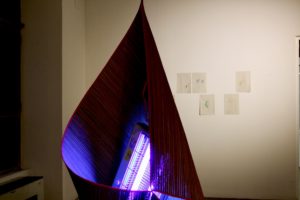
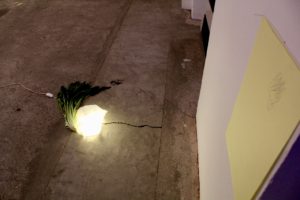
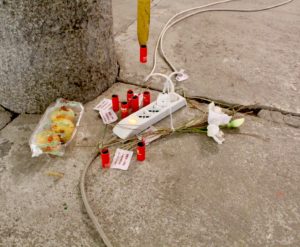
The working method of French artist Andréa Spartà is based on the observation, collection and subsequent reworking of his daily surroundings.
“My works begin with a direct observation of everyday life and of the situations in which I find myself, they are the result of my being there at that moment”.
The artist internalises and returns this imagery, filtered through his perception: “I aim at translating everything I see into a kind of metaphor. I create drawings and installations from photos I take of everyday life whose features are reminiscent of the images with blurred contours that fill our minds at the moment when we are about to fall asleep, in that moment of limbo between wakefulness and sleep in which we start to re-elaborate the events of our day”.
The series of installations and drawings that Spartà presented at the open studio are entitled Weather Report: “I often resort to the idea of the weather report because what fascinates me most is the fact that this is a tool for studying the past, predicting the future, and allowing us to know what is happening in a given place at a given time. My works don’t actually follow a chronological order as in a weather report, but only refer to certain precise moments that particularly caught my attention. Working with the nature of a specific place, everything refers to the period spent here in Biella and at Cittadellarte”.
Juliette Alhmah
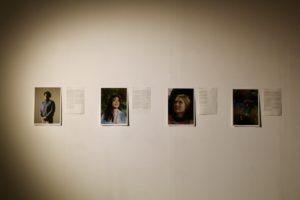
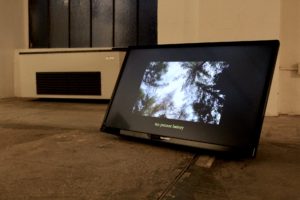

At the open studio, the French photographer presented A lucky charm and some good shoes, an ongoing research focused on women’s solo journeys exploring human relationships, intimacy, emotions and the resulting narratives. This theme is part of the broader subject of women, their bodies and their safety in public spaces.
“I chose this as the topic from which to start my research as I myself am a woman and often travel alone. I am also part of the project Nouveau Grand Tour, inspired by the 18th century Grand Tour tradition of artists travelling to other countries to discover the local artistic heritage, so I am also a travelling woman artist”.
What if Ulysses had been a woman? What if Penelope had not had to stay in Ithaca to wait for him? The idea of the journey and adventure story has always been immediately associated with masculinity. If she is not at home patiently waiting, the woman is seen at best as a pleasant travelling companion, at worst, i.e. when she ventures out alone, as reckless or a possible sexual conquest. Alhmah’s project aims at reversing the narrative by analysing these issues from another perspective.
“Women’s travel stories exist, but we know very little about them. That is why I started a research project right here in Biella on women’s solo journeys, to make these stories known. I met women who had to leave to find work, women who did it by choice, and others who set out with faith to go on a pilgrimage”.
A lucky charm and some good shoes is based on in-depth literary and historical research carried out by Ahlmah in archives and libraries in the area, and combines meetings, testimonies and photographs of women from Biella.
“The idea was to meet women and talk about their relationship with the journey, their experiences and memories. If they agree, I record their voices and take portraits of them. The goal is to make a film in which these stories are interwoven with local legends and tales, and with some of my personal memories, to create an audiovisual journey”.
Shaima Hamad
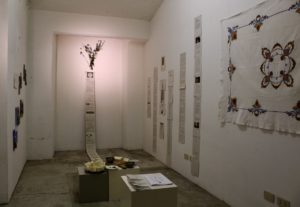
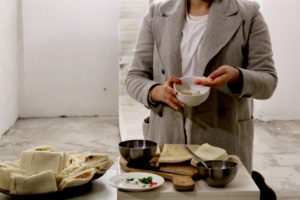
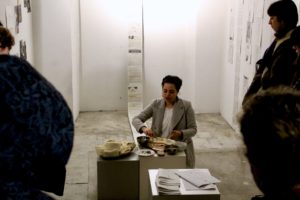
Shaima Hamad, a Palestinian visual and performance artist, ended her residency presenting her research on the Jerusalem artichoke through a culinary art performance.
“I already knew some Palestinian recipes using this tuber, but I had practically forgotten about it until I arrived here in Biella and was invited to a dinner where I rediscovered this flavour. Asking what it was, I was told that the dish I had just tasted was made with Jerusalem artichoke”.
This plant grows mainly in wet areas and spreads abundantly near water courses so it is very common in Piedmont.
“I started doing some research on this plant as I had never heard of it in Palestine under the name Jerusalem artichoke, and in an almost magical way, this plant took me to far and very different places around the world. The origin of this plant can be found in Latin America; passing through France, Italy, Palestine and finally arriving in England, the Jerusalem artichoke brings together a stratification of stories that relate to history itself: colonisation, identity and my own direct personal experience”.
In Bread Without Borders Hamad uses the art of cooking to document and protect the food practices and stories of her tradition while uniting them with the story of all the experiences lived and made at Cittadellarte.
“I have always brought the beauty of culinary tradition into my artistic practice. The action of cooking is a human act and I can communicate well through this language. When you prepare food, you often combine several traditions creating new flavours that can change what you felt and knew until a moment before. I am very grateful to this plant and I love the yellow of its flowers. I found myself in the right place at the right time to shed light on these connections through my research and performance”.
Marco Cassani
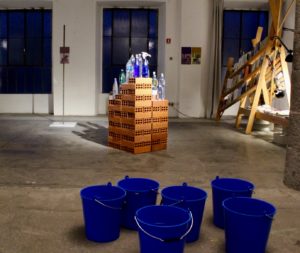
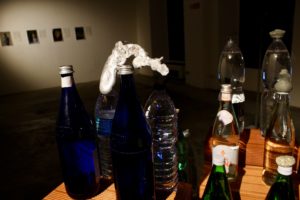
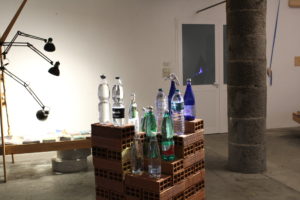
Italian conceptual artist who has now been living in Bali for 13 years. Initially trained as a painter, over time his practice has adopted an artistic language and method that question specific emblems and social codes, particularly those related to political and collective power, using art as a ‘catalyst’ to create a new understanding towards the construction of value.
Exchange is the project he presented at the open studio. The project began with the installation of the sculptural work Ti Amo (I love you) as a wishing fountain positioned in the inner courtyard of Cittadellarte – Fondazione Pistoletto (full details in our previous article).
“The work is inspired by the Balinese ritual and the Italian tradition of expressing a personal wish by throwing a coin into a sacred spring or fountain. The title of the installation is therefore a reference to my country of origin and to Michelangelo Pistoletto’s work ‘I love you’, which I (re)discovered during my residency at Cittadellarte. From this point of view, the fountain has a profound relationship with love and belief: it creates an intimate but at the same time public space in which people meet to express a wish. I chose to place it in the square of the Foundation because this is where fountains are usually positioned, but at the same time I didn’t want to put it in the centre because I share Pistoletto’s vision that there is no single centre”.
Through this research focused on water and its distribution, this universal element is investigated in relation to the social function of fountains.
“Water is a universal element and has always been the basis of human life. Water means life, love and value, but these decline depending on the environment and social context in which we find ourselves. Throwing a coin into a fountain is an absolutely human act. My idea is to try to strike chords that we often forget about, which are, in my opinion, those that are intrinsically part of us. With my work, I want to create a value connection around the same element from two perspectives that are as distant geographically as they are similar: Bali and Biella. It is interesting to notice how in Italy the vision of water relates more and more to its democratisation and to our needs as we move away from its source, whereas the Balinese maintain their connection to water springs through daily rituals of offering, which is somehow similar to what the people of Biella once did with the river Cervo. I discovered this during my residency, when I visited the Museum of the Biellese Territory and I was shown a sword found in the bed of the watercourse that had once been given to the river as an offering”.
At the open studio, Cassani also exhibited a visual archive of all the materials and objects he had collected, to emphasise that: “The concept of the archive for me is like going back to the source and finding the spring”.
Ginevra Naldini and Marco Isaias Bertoglio
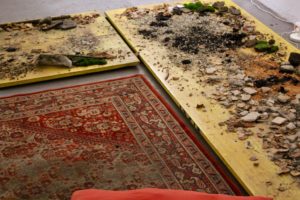
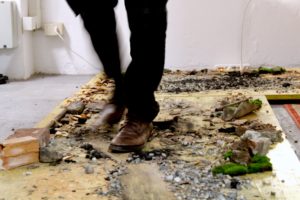
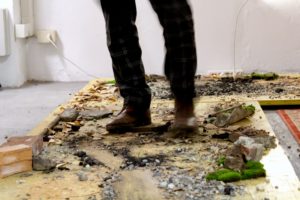
The research that Ginevra Naldini and Marco Isaias Bertoglio have developed together sees the human body and its senses as the main active tools for investigating the contexts that surround us.
“The relationship between sound and the environment, the role the body plays as a research tool through the sound it creates and perceives. Sound binds through difference, it traverses space and permeates it. Listening at the same time, both sonically and anthropologically and politically, plays the role of a bridge between us and the other, between what we perceive to be within us and what is outside us. Sound as language is much more immediate, emotional and sensorial”.
Sound-Walk, Micro-Geography of Engagements and Sound-Movement Installation is an interactive sound installation that aims at acoustically evoking a walk through the east-urban area of Biella and its disused industrial buildings.
“The use of sound, listening and the body as tools for investigation has always been our methodology, – Ginevra and Marco have developed it in London and Madrid respectively, – going to explore certain types of spaces during the residency, we asked ourselves how we could analyse them, and our immediate answer was through the use of sound”.
The installation consists of two ‘interactive’ wooden platforms connected to contact microphones, so that, as people walk on them, they can hear the sound of their own footsteps amplified. This is to “bring the idea that sound doesn’t simply exist around us, but we ourselves primarily create it”. The sound from these platforms is not only amplified, it is also modified with a bit of a reverberation effect so as to give the idea of walking in a large, disused space where noises echo, such as the space of the former Rivetti factory (actually visited by Naldini and Bertoglio). These platforms were covered with gravel, stones, dried leaves, earth, rubble and moss to make the sound produced more realistic and evocative. In parallel, the artists created a soundscape.
“The soundscape of the Biella neighbourhood of San Paolo is reproduced on a loop in the open studio. First, we recorded the sounds of that area (traffic, bells, the noises from a school at recess, from inside supermarkets such as Esselunga and Aldi); we then selected 36 of them and reassembled them to create this feeling of a walk, of a person and a body moving in a certain space. When visiting the open studio, this soundscape interacts with the sounds created by the footsteps of people walking on the platforms. The city is perceived as a bodily experience, walking as a ritual to collectivise future decisions. This is meant to translate into a micro-geography of active engagement in the formulation of alternative futures for this landscape”.

